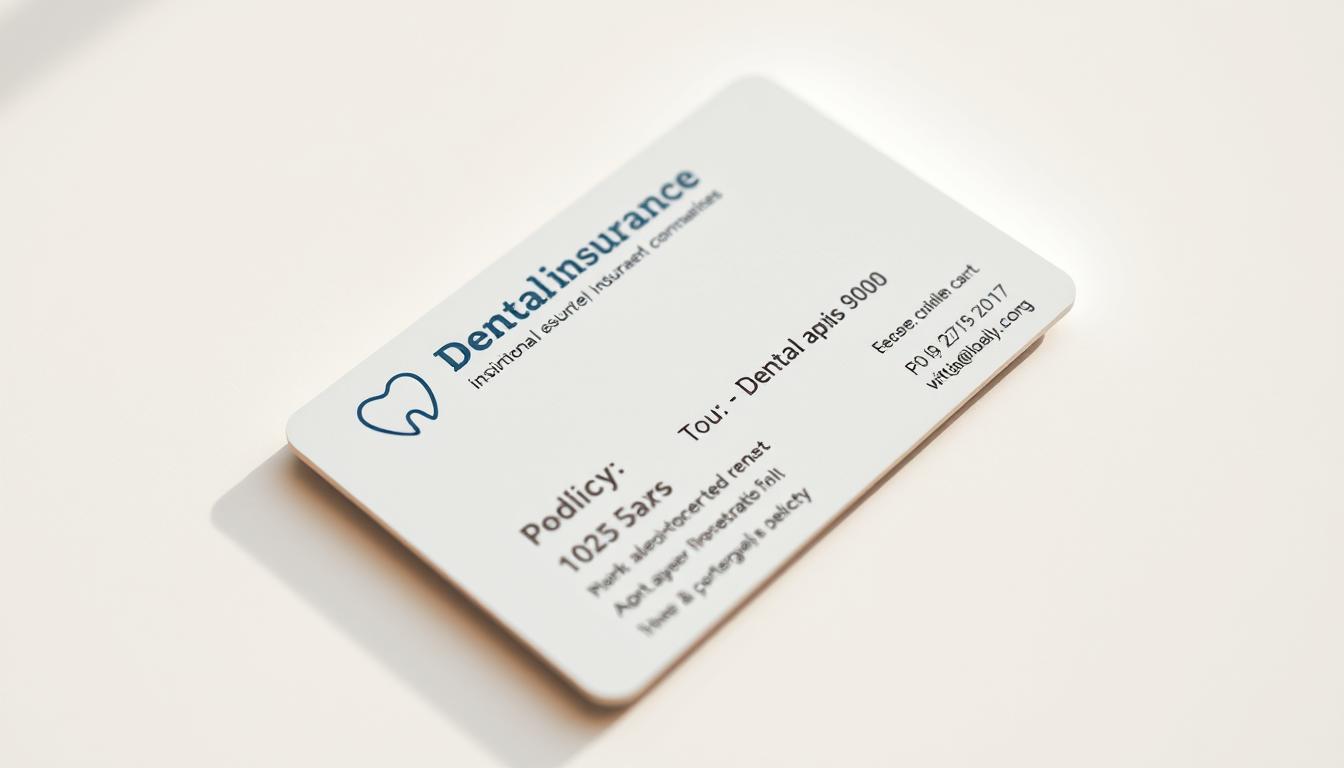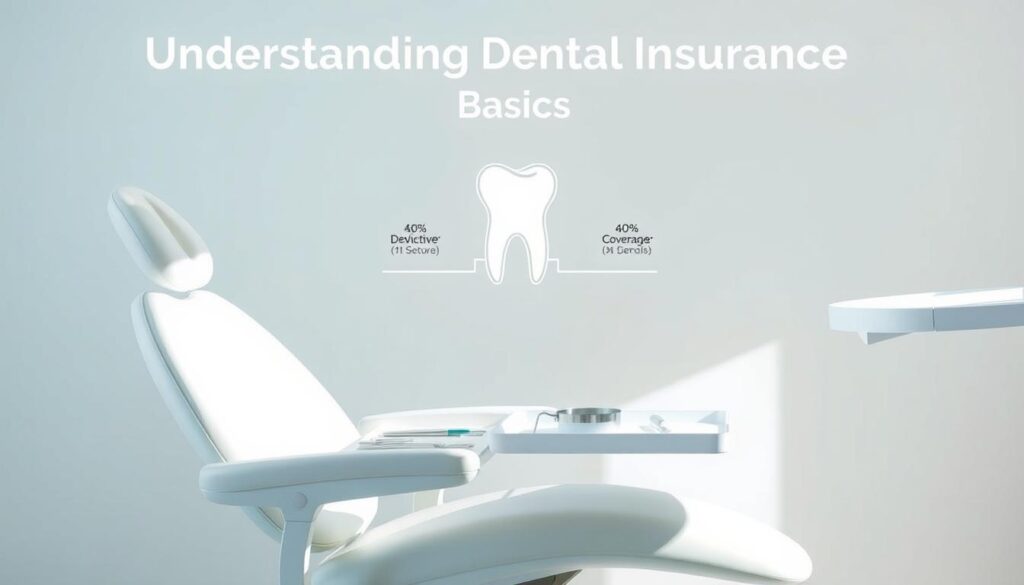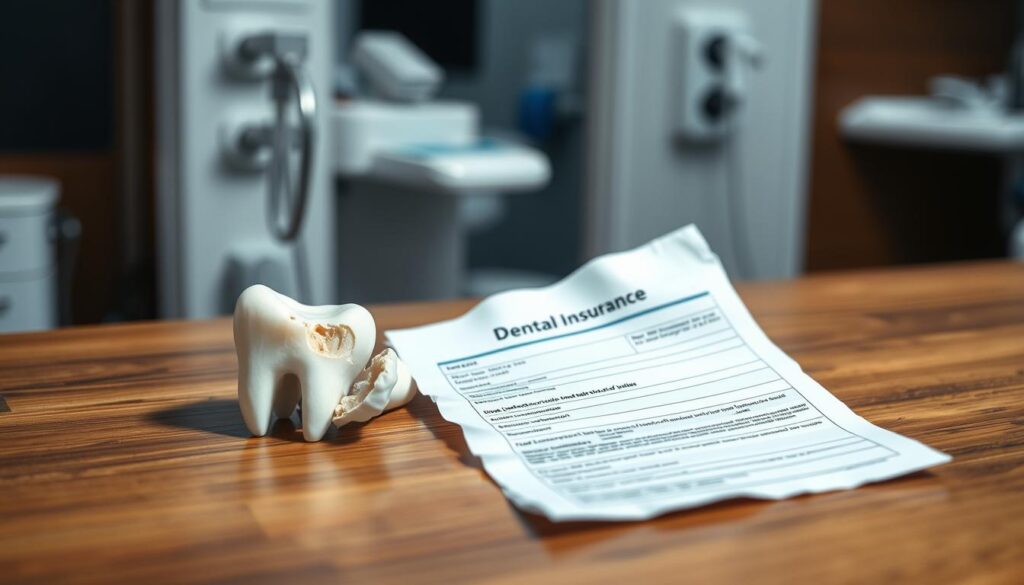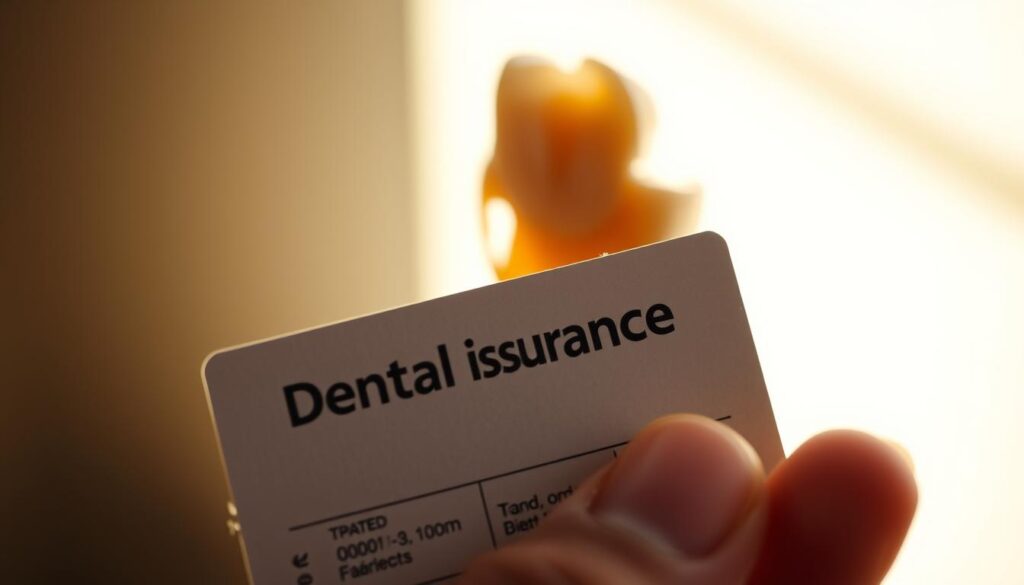Will My Dental Insurance Cover Fixing a Broken Tooth?

Did you know over five million teeth are knocked out each year in the United States? This shows how urgent it is when a tooth cracks or fractures.
Will my dental insurance cover fixing a broken tooth? This depends on your policy, the damage’s extent, and if you need preauthorization. Check if your plan covers emergency or restorative treatments. Some policies have yearly maximums that limit coverage. Also, having an in-network provider can help guide you.
Key Takeaways
- A broken tooth may qualify for coverage under certain policy terms.
- Waiting periods and annual allowances can affect claims.
- An in-network dentist can reduce out-of-pocket costs.
- Preauthorization is often needed for major restorative work.
- Early treatment helps avoid expensive complications.
Understanding Dental Insurance Basics
Many people are curious about premiums, deductibles, and co-pays in dental insurance. Plans have rules on how often you can get care and waiting times. Knowing these details helps you get the right treatment for a broken tooth.

What is Dental Insurance?
Dental insurance helps manage the cost of dental care. Insurers work with providers who agree on payment terms. Our goal is to help you find coverage that keeps costs down.
Types of Dental Insurance Plans
There are plans that are affordable and others that offer more choices. Each type affects how you get care and what benefits you get. Here’s a look at some common plans:
| Plan | Key Attributes |
|---|---|
| PPO | Flexible network with varied premiums |
| DHMO | Lower monthly costs but limited provider choices |
| Indemnity | Freedom to choose any dentist, yet higher fees |
How Does Dental Insurance Work?
People pay monthly premiums and a deductible before they share costs. For big procedures like fixing a broken tooth, you might need to get approval first. Knowing your coverage and how to file claims helps you get care on time. This keeps your teeth healthy.
Common Dental Procedures for Broken Teeth
A chipped or fractured tooth needs quick attention. Dentists look at how bad it is, where it is, and the tooth’s overall health. Many people check if their insurance covers fixing a broken tooth to avoid high costs.
Even though it might hurt a bit, today’s dentistry has ways to fix it without losing the tooth. These methods help keep your mouth working right and look good too.
Fillings and Bonding
Small chips or cracks can be fixed with fillings or bonding. This method uses special materials that stick to your tooth. It keeps your tooth strong and prevents bigger problems.
Crowns and Caps
Bigger breaks might need a crown to protect the tooth. Crowns are like strong shields for your teeth. Caps help your teeth handle everyday chewing and keep them safe.
Root Canals
Big breaks can hurt the tooth’s inside. Root canal therapy is key to save the tooth. It’s a way to keep your tooth working and feeling normal again.
| Procedure | When Recommended | Insurance Aspect |
|---|---|---|
| Fillings/Bonding | Minor chips | Often partly covered |
| Crowns/Caps | Larger fractures | May include partial coverage |
| Root Canal | Severe tooth damage | Coverage varies per policy |
Factors Influencing Coverage
Getting coverage for a broken tooth depends on several things. When you file a claim, you might need to decide if it’s a simple fix or a big treatment. Insurance plans differ in what they cover, so knowing your options is key.

Type of Policy
Some jobs offer dental benefits from big names like Delta Dental or Cigna. These companies might see crowns as major work, which can affect how much you get back. Some plans have their own rules for what’s covered. Knowing these details helps you understand what you might have to pay for.
Age and Health of the Tooth
Older teeth or ones that have been fixed before might need more complex care. This could mean crowns or even root canals. Dentists will suggest the best treatment, but insurance companies will check if it’s covered.
Waiting Periods
New members might have to wait before getting major treatments covered. Could this wait hurt if you need urgent dental care? Knowing these waiting times helps you plan and avoid unexpected costs.
Typical Coverage for Broken Tooth Repair
Dental insurance plans divide repairs into basic and major services. This depends on the procedure’s complexity. It’s important to check what each plan covers before getting treatment.

Insurance for broken tooth repairs often suggests using in-network dentists. This can save money due to lower rates. To know if you need urgent care, visit this resource.
In-Network vs. Out-of-Network Benefits
Insurance companies work with certain dentists. Going to in-network dentists can lower costs. But, out-of-network care might cost more, even if it’s covered.
Coverage Limits and Maximums
Some plans have yearly limits. After reaching this limit, you must pay for any more care. Basic fixes like fillings might be covered, but bigger repairs could cost you more.
Percentage of Costs Covered
Insurance for broken teeth usually covers a certain percentage. For simple fixes, you might pay 20% of the cost. But, for complex treatments, you could pay half or more. Insurers often need to approve these treatments first, so you know what to expect financially.
The Importance of Preventive Care
Good dental habits keep you healthy and save money. Regular check-ups can catch problems early. This might help lower costs for a broken tooth claim.

Regular Check-Ups
Regular exams find small issues before they get worse. This makes fixing them cheaper. Dentists, like those in the American Dental Association, say see them every six months.
For more tips on handling tooth damage, check out this guide.
Dental Hygiene Practices
Good home care strengthens teeth against decay. Key steps include:
- Using fluoride-based toothpaste
- Brushing for two minutes twice a day
- Flossing to remove debris between teeth
These habits can prevent problems that might lead to a claim.
Early Intervention
Fixing small issues early is often easier. This approach leads to better results and fewer complications. Quick action can also keep your teeth healthy for longer.
What to Do Immediately After a Tooth Breaks
When a tooth breaks, acting fast can help. It can make you feel better and prevent bigger problems. Quick actions are key to keeping your teeth healthy and making insurance claims easier.
Acting quickly can save your tooth and prevent more damage. Pain and swelling often get better faster with early care. Getting help from a dentist as soon as possible is important for your tooth’s health.
First Aid Steps
Rinse your mouth with warm water to remove any debris. Put any tooth pieces in a container of saliva or milk. Use a cold compress on your cheek to ease pain. These steps help keep your tooth stable until you see a dentist.
When to See a Dentist
Seeing a dentist right away is important. They can check for hidden damage. Getting treatment quickly helps you get the most from your dental insurance.
Documenting the Incident
Take pictures and write down what happened right after your tooth breaks. Include the time it happened and any witness statements. This information is important for insurance claims and getting the right treatment.
Navigating Claims Process for Treatment
People looking into broken tooth coverage under dental insurance need a clear guide for submitting claims. Getting ready ahead of time can clear up any confusion. Is everything in order for a quick decision?
Big names like Delta Dental and Cigna tell policyholders to check if treatments need preapproval. This step avoids unexpected issues and makes the claim process more confident.
Filing a Claim
Insurance companies ask for details like procedure codes, itemized receipts, and service dates. Providing the right information can increase your chances of approval. Many places let you file online, but some prefer paper forms sent by mail.
Necessary Documentation
Dental X-rays, treatment plans, and proof of payment show the treatment’s need. Keeping these documents together speeds up the review process. A well-organized set of documents helps everyone involved understand the situation better.
Timeframe for Claim Processing
How long it takes to process claims varies by policy. Some insurers make decisions in days, while others take weeks. You can track your claim online or by calling to find out when you might get your money back.
Understanding Exclusions in Your Policy
Some dental plans have unexpected limits for fixing broken teeth. Dentists and patients might be surprised if they don’t know these details. Knowing what’s covered and what’s not is key for everyone’s oral health.

What to Look Out For
Insurance plans list what they don’t cover clearly. Look for exclusions in categories like cosmetic fixes or repeated treatments in a short time. It’s also important to check renewal clauses and if certain procedures need reevaluation.
Common Exclusions
Some plans don’t cover preexisting damage, sedation, or optional restorations. They might also not cover frequent replacements in the same year. Asking if a broken tooth repair gets partial reimbursement can save time.
How to Ask Insurance Questions
Talking directly to an agent can clear up confusion. It’s smart to ask for written proof about exclusions or coverage needs. Knowing about sedation limits, upgrades, or replacement rules helps everyone feel more confident.
| Exclusion Type | Reason | Possible Step |
|---|---|---|
| Cosmetic Treatments | Not regarded as medically necessary | Seek partial coverage if function improves |
| Preexisting Damage | Condition noted prior to policy | Submit documented updates from dentist |
| Sedation Coverage | Extra expense categorized as optional | Negotiate flexible payment arrangements |
The Role of Employer-Sponsored Insurance
Having a broken tooth can lead to urgent dental care expenses. Employer-sponsored insurance often offers financial relief through group rates and simplified enrollment. This approach may reduce out-of-pocket costs and give employees more robust support for serious conditions.

Benefits of Employer Plans
Many employer-sponsored packages include higher coverage percentages for emergency treatments. They frequently streamline claims, helping policyholders secure prompt care. Working with a human resources department can bring clarity on specific benefits tied to dental repairs or endodontic procedures.
Comparing Individual Plans
Individual policies vary in cost and level of coverage. Group plans under an employer can unify fees across multiple participants. This arrangement can lessen personal premiums and enhance the scope of covered services. It can be wise to compare plan terms before making a final selection.
Employee Assistance Programs
Some workplaces offer Employee Assistance Programs that address diverse health issues. These resources may range from financial counseling to crisis management and referral options for urgent procedures. They often serve as an additional layer of support, guiding employees through major dental challenges.
The Significance of Dental Networks
Choosing a network-focused plan can really help with unexpected costs like fixing a broken tooth. Insurers work with in-network dentists to set negotiated rates. This means lower costs and fewer surprises for you.
Check out this broken tooth guide for tips on fixing teeth.
Preferred Provider Organizations (PPOs)
PPO plans let you see many providers, including those outside the network. Visits outside the network might cost more. But, many people like the wide choice of specialists.
This model is great for those who want to pick their own dentist.
Dental Health Maintenance Organizations (DHMOs)
DHMOs ask you to choose a primary dentist from a small list. Costs are usually low, thanks to careful management. This system focuses on quick referrals and covered services at set rates.
Advantages of Staying In-Network
In-network providers agree to fixed fees, keeping costs down. This setup helps with predictable billing during emergencies. It makes claims easier for both patients and dentists.
| Network Type | Key Benefit | Flexibility |
|---|---|---|
| PPO | Broad provider choices | Can go out-of-network |
| DHMO | Lower fixed expenses | Must use designated dentists |
Financial Assistance Options
Unexpected dental costs can be tough on your budget. Many people look for help to cover these expenses. This way, they can get the dental care they need without financial stress.
Setting aside money in special accounts can help with immediate costs. You can use pre-tax contributions and flexible payment plans. This helps both patients and providers find solutions.
Flexible Spending Accounts (FSAs)
FSAs let you set aside money before taxes for healthcare. This includes dental care, which can help with unexpected costs. Make sure to check your plan’s rules to use these funds wisely.
Health Savings Accounts (HSAs)
HSAs work with high-deductible insurance plans. You can put money in them before taxes. You can use this money for dental care, including emergencies. Keep records of your dental expenses to get reimbursed faster.
Dental Care Credit Lines
Credit lines just for dental care can help with uncovered costs. They offer flexible payments to help you afford necessary treatments. This way, you can manage monthly payments and get the care you need.
How to Choose the Right Plan for Your Needs
Finding the right dental plan means knowing what’s covered and any waiting times. You need to think about big treatments like crowns or root canals. Look at what Delta Dental or MetLife offers.
Plans differ in how much they cover and what they don’t. It’s smart to check these details to save money and keep your teeth healthy. By looking closely at what each plan offers, you can make a choice based on facts.
Evaluating Coverage Options
Each policy has basic, preventive, and major restorative parts. Some have waiting times for certain treatments. Others have big networks of dentists, which can cut costs.
Cost vs. Benefits Analysis
Think about the monthly cost, deductibles, and coinsurance. Compare these to what treatments might cost. A clear plan helps avoid unexpected bills for things like implants or veneers.
Customer Reviews and Satisfaction
People often talk about their experiences with claims and service. Online forums can show if Cigna or Guardian works for you. Reading honest reviews helps you feel sure about your choice.
| Plan Feature | Key Consideration |
|---|---|
| Annual Maximums | Limits on total coverage per year |
| Waiting Periods | Time before major treatments begin |
| Coinsurance Rates | Percentage of costs paid by patient |
| In-Network Providers | Discounted rates through select dentists |
| Claim Processing | Speed and ease of reimbursements |
Tips for Maximizing Your Benefits
Planning ahead is key to saving money and keeping your teeth healthy. Some people book dental visits at the end of the year to use up their coverage. Others spread out their dental care to keep their teeth in top shape.
It’s smart to think about how each part of your insurance can help you save more.
Plan Ahead for Procedures
Some dental work, like fillings or crowns, has limits on how often you can get it. Booking these treatments early can save you from big bills later. Catching small problems early can also prevent bigger, more expensive fixes.
Understanding Annual Maximums
Every dental insurance plan has a spending limit. Knowing this limit helps you plan when to get dental work done. By splitting big treatments over two years, you can avoid using up all your coverage at once.
Utilizing Preventive Care
Regular check-ups can find problems before they get worse. Many plans cover preventive care well. Going for regular check-ups can strengthen your teeth and save you money in the long run.
How to Handle Denied Claims
Unexpected coverage refusals can really slow down getting the care you need. Having clear documents and talking things over can help avoid big problems. Getting ready well can make it easier to change the insurer’s mind.
Common Reasons for Denials
Forms not filled out right or missing X-rays can cause denials. Policy rules about when you can get help can also block access. Not getting approval before treatment is another common reason.
- Insufficient proof of medical necessity
- Lack of required pre-treatment approval
- Excluded treatments in the policy
Steps to Appeal a Decision
- Gather updated exam findings and dentist statements.
- Submit an official appeal with valid documents.
- Request an internal review of your case if needed.
Seeking Help from Insurance Reps
Talking to insurance reps can help clear up any confusion. Direct calls can open up conversations that emails can’t. Showing strong evidence might change the insurer’s mind.
| Reason | Recommended Action |
|---|---|
| Missing Documents | Attach complete exam records |
| Policy Exclusion | Check if other treatments are covered |
| Preauthorization Issue | Try to get approval after the fact |
FAQs About Dental Insurance and Tooth Repair
Many people want to know how their dental insurance works when they have a broken tooth. We’ve got answers to common questions about changing plans, extra procedures, and waiting times.
Can I switch plans mid-year?
Switching plans in the middle of the year can lead to new deductibles or waiting times. It’s wise to check with your insurance company about any changes. Keep records of any updates for future use.
What happens if I need additional work?
If you find out you need more work after the initial fix, it’s okay. Just send in new pre-authorizations and accurate records. This can help get your coverage approved faster. Talking clearly with your dentist ensures your insurance is handled right.
“Confirming plan details before scheduling any extra procedure can prevent unexpected costs and streamline the entire dental insurance process.”
Are there waiting periods for new procedures?
Some insurance plans have waiting times for certain treatments. It’s important to check your plan documents. This helps plan appointments without delays, which is key for complex work.
Consulting with a Dentist
Talking to a trusted dentist can clear up dental insurance questions. This step boosts confidence in handling broken tooth coverage or other dental needs. Reading about recommended check-ups from this resource prepares you for future visits.
Questions to Ask Your Dentist
Ask about risks, recovery times, and insurance claims. Knowing if certain materials or methods cost more is smart. Open talks clarify what’s covered and what you’ll pay out of pocket.
Importance of a Treatment Plan
A treatment plan outlines the timeline, procedures, and costs. It helps understand insurance benefits, like for root canals or crowns. It also helps plan treatments within policy windows.
Building a Relationship with Your Dental Provider
Working with the same dentist builds trust and encourages regular check-ups. Catching small issues early can save money. A long-term relationship makes insurance talks smoother and helps plan for future needs.


